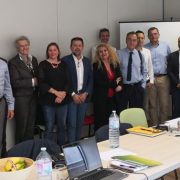García Tejerina advocates an inclusive and supportive approach in water transfers
Minister of Agriculture, Food and Environment, Isabel García Tejerina, stressed the importance of water planning, efficient management and an active dialogue with stakeholders, to develop a water policy. Also she pointed out the need for implement an integrated and united approach to transfers, to bring water to deficit areas. in this regard, the minister, who made these statements in the ABC water Forum, held on 8 June- cited as an example the Tagus Agreement -Segura, where there has been “a great effort to reach consensus operating rules, transparent and safe” in recent years, eliminating the discretion operation.
In the framework of this Forum García Tejerina praised the work of the Government to overcome the backlog in previous legislatures in Spain obligations with the EU for the first planning cycle, and complete the second cycle (2015-2021), encompassing the beat the other member countries. The minister stressed that this effort has been supported on the basis of technical rigor and broad public participation, which has allowed to know the needs, available resources and the actions that must be promoted.
Thus, García Tejerina explained that the new basin plans establish guidelines water policy until 2021. It is 12 plans of state competition, approved by the Government in January this year, totaling more than 10,000 steps to run until 2021, with an estimated 15,000 million euros investment. This may be meet supply needs, by building reservoirs and pipelines, and the expansion and modernization of irrigation.
Unconventional resources, such as desalination will also be incorporated, and will meet the environmental objectives, with actions in sanitation and water treatment, or river restoration.
On the other hand, the minister pointed out that the Government has also approved plans for flood risk management of all demarcations of state competition, with a planned investment of 800 million euros for the period 2016-2021. Its objectives include improving the predictive ability in situations of flood and flooding, and reduce the vulnerability of the elements located in flood-prone areas.
Another action remembered by García Tejerina have been the drought plans, where coordination has allowed preventive measures before achieving substantial reductions in reserves.
It has also highlighted the investment made in infrastructure, such as those included in the Water Pact of Aragon and the progress made in dams Enciso and Soto-Terroba (La Rioja), Los Melonares (Sevilla) or the completion of the dam Siles (Jaén).
Source: MAGRAMA
















